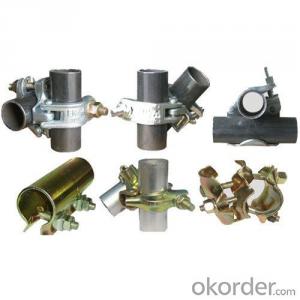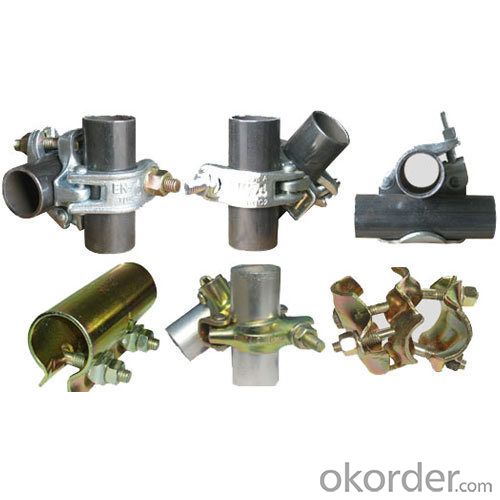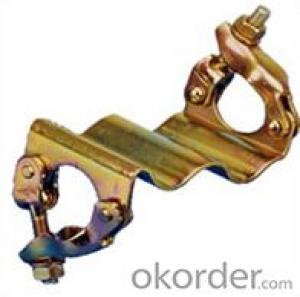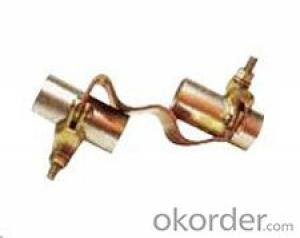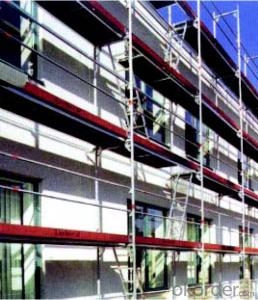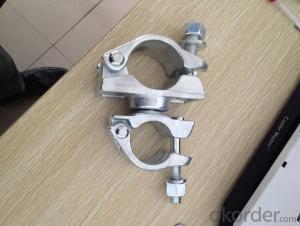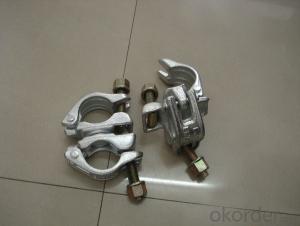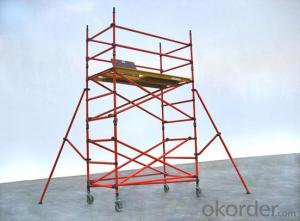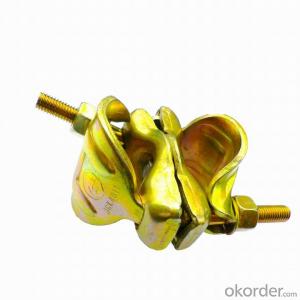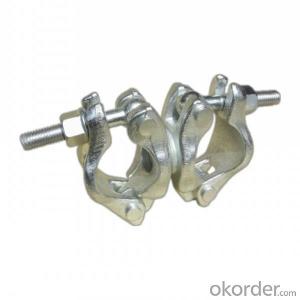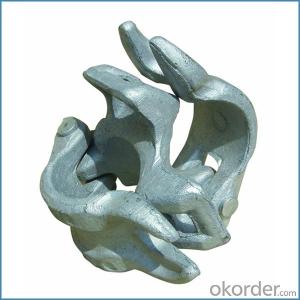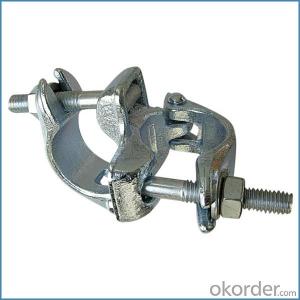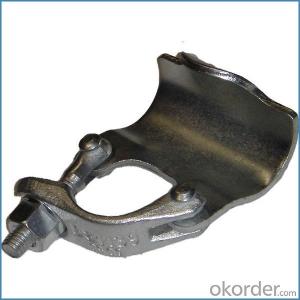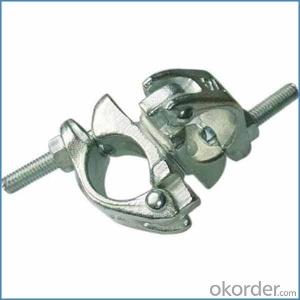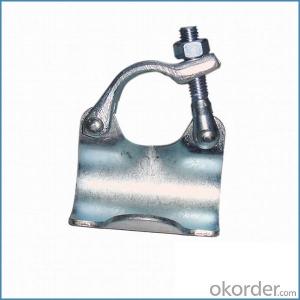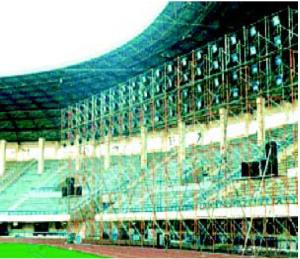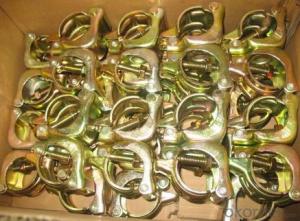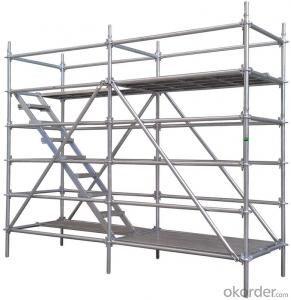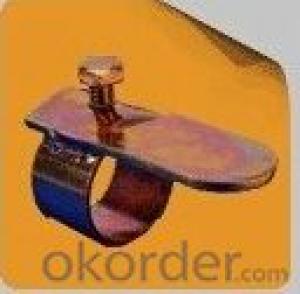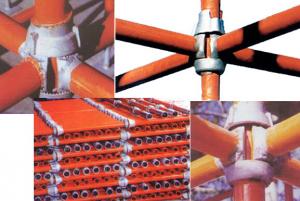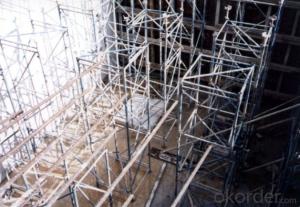Scaffolding Wedge Clamp british German Forged Type
- Loading Port:
- Tianjin
- Payment Terms:
- TT OR LC
- Min Order Qty:
- 1000 kg
- Supply Capability:
- 100000 kg/month
OKorder Service Pledge
OKorder Financial Service
You Might Also Like
Scaffolding Wedge Clamp british German Forged Type
Description
1.The scaffolding coupler is always used to connect the steel pipe as scaffolding system.
2.The often used coupler is swivel coupler and righ angle coupler .
3.We can provide types of scaffolding coupler according to your requirement.
4.Couoler can fix the 48.3mm scaffolding steel pipe tightly and make the whole scaffolding system more steadily.
Feature
(1)Excellent Anti-Breaking—Cold Pressed Steel
(2)Outstanding Resistance Deformation
(3)Strong Anti-Dropping Ability
Photo
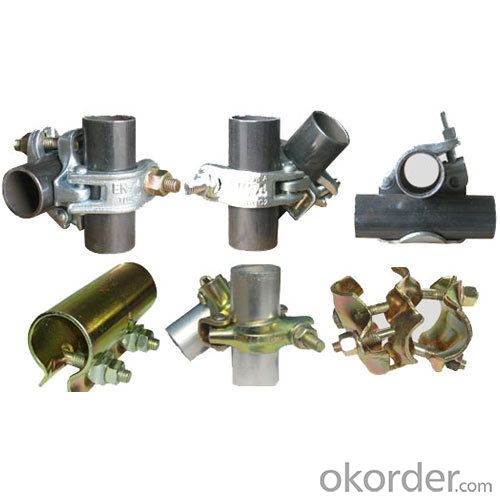
Parameter
| Material | Q235,345steel |
| Size | 48.3mm*48.3mm |
| Surface finish | Galvanized |
| Weight | 1.1kg around |
| Standard | BS1139,EN74 |
| Package | 25pcs/bag,steel pallet |
| Manufacture | As per customer requirement |
| Market | Africa, South America, the Middle East and Asia |
FAQ
Q: Are you a factory or trading company?
We are a state-owned corporation in China,dealing with various kinds of building materials.We have our holding subsidiaries.
Q: Where is your factory located? How can I visit there?
Our factory is located all around China.
Q: Can I get some samples?
Sample is free, customer only pay freight for the first time.
Q: Delivery?
10-30days. (5-15 containers)
Any question,feel free to contact us.
- Q: why scaffolds need to be inspected within the preeceding 7 days and after adverse weather condition?
- If you have inspected the scaffolding within a week before a storm and then again directly after, you will be able to find damage that happened in the storm. If you hadn't inspected it in a month, you might not be able to tell if the damage you find after the storm was caused by the storm or from something else before the storm that you never saw because it had been so long since the last inspection.
- Q: what did dimmesdale do?what was the result??
- uhm i dont know the exact two things that send Dimmesdale to the scaffold, but i know that he went there because he felt guilty for not standing up for Hester Prynne and making her show her sin alone when it was his sin too, and he feels that if he goes up to the scaffold he will be relieved of his guilt and will feel better.
- Q: What are the healing times for a tragus and scaffolding peircing? Apporimatly?
- 6 months to a year. All ear cartilage are the same.
- Q: Are steel tube couplers compatible with scaffolding systems using different tube lengths?
- Scaffolding systems that utilize different tube lengths can typically be paired with steel tube couplers. The purpose of these couplers is to securely connect the tubes used in scaffolding systems. They are designed to accommodate various tube sizes and lengths, allowing for adaptability and versatility in the construction of scaffolding. When using steel tube couplers with scaffolding systems that have varying tube lengths, it is crucial to consider the size and strength of the couplers. This ensures that they can handle the load and maintain the stability of the structure. Selecting couplers that are compatible with the specific tube sizes and lengths used in the scaffolding system is of utmost importance. In some instances, additional measures may be necessary. This includes using adjustable couplers or providing extra support to account for the different tube lengths. Following the manufacturer's guidelines and specifications for the couplers is also essential to ensure the safe and reliable construction of the scaffolding. In conclusion, by choosing the appropriate couplers and installing them correctly, steel tube couplers can be compatible with scaffolding systems that use different tube lengths. They provide the necessary structural integrity and stability required for safe and efficient construction projects.
- Q: Can steel tube couplers be used in scaffolding projects with specific height or reach requirements?
- Yes, steel tube couplers can be used in scaffolding projects with specific height or reach requirements. Steel tube couplers are commonly used in scaffolding systems to connect and secure tubes, providing stability and strength. They can be used to construct scaffolding structures of varying heights and reaches, allowing for flexibility and adaptability in meeting specific project requirements.
- Q: okay here is the thing. i wanted to know if its called an industrial or scaffold piercing and if i can get it at thirteen, im thinking i can because its on the ear but not sure may be wrong. and any warnings or anything about getting it done...please do not be shy with giving me info on it thanks :]]
- it's industrial. i really like it =]
- Q: What are the common challenges in using steel tube couplers in scaffolding?
- When using steel tube couplers in scaffolding, there are several challenges that may arise. Firstly, ensuring proper installation and alignment of the couplers can be a challenge. It is important to securely attach the couplers to the tubes and align them correctly to ensure stability and safety. This requires careful attention to detail and expertise in scaffolding assembly. Secondly, rust and corrosion can pose a significant challenge when using steel tube couplers. Steel is prone to rust, and if the couplers are not adequately coated or maintained, they can deteriorate over time. This can compromise the integrity of the scaffolding structure and create a safety risk. Regular inspection and maintenance, along with the use of corrosion-resistant coatings, can help address this challenge. Another challenge is the weight and size of the couplers. Steel tube couplers tend to be heavy and bulky, which can make them difficult to handle and transport. As a result, the time and effort required for scaffolding assembly and disassembly can increase. Additionally, the weight of the couplers can strain the scaffolding structure, necessitating careful consideration of load capacities and weight distribution. Furthermore, compatibility with different tube sizes can be a challenging aspect. Steel tube couplers are available in various sizes to accommodate different tube diameters, but ensuring the correct fit can be a challenge. It is crucial to select couplers that are compatible with the specific tubes being used and to follow manufacturer guidelines for installation. Lastly, cost can also present a challenge when using steel tube couplers. Steel is generally more expensive compared to alternative materials used in scaffolding, such as aluminum or plastic. This can result in higher overall project costs, especially for larger scaffolding structures. In conclusion, while steel tube couplers are widely utilized in scaffolding due to their strength and durability, they bring their own set of challenges. Proper installation, maintenance, rust prevention, handling, compatibility, and cost considerations are essential in ensuring safe and efficient scaffolding operations.
- Q: How do steel tube couplers prevent tubes from separating under load?
- By creating a strong and secure connection, steel tube couplers prevent the separation of tubes under load. These couplers are specifically designed to join two or more steel tubes together, ensuring their rigidity and stability even when exposed to heavy loads or external forces. One of the main advantages of steel tube couplers is their ability to mechanically interlock the tubes. This means that the coupler physically grasps the tubes, establishing a tight and dependable connection. This interlocking mechanism can be achieved through various methods, such as threaded connections, bolted flanges, or internal wedges. Regardless of the specific design, the primary objective is to generate a frictional force between the coupler and the tubes, preventing any relative movement or separation. Moreover, steel tube couplers often incorporate additional features to improve their load-bearing capacity. For instance, some couplers may include internal or external reinforcement plates that evenly distribute the load across the joint, minimizing stress concentrations. Others may have special sealing mechanisms to prevent the entry of moisture, corrosion, or other contaminants that could weaken the joint over time. Furthermore, steel tube couplers are typically manufactured from high-strength materials, such as carbon or alloy steel, which can withstand significant loads without deforming or failing. These materials possess excellent tensile strength, enabling them to handle the forces exerted on the joint and resist any tendency for the tubes to separate. Couplers are also frequently designed with safety factors to ensure a sufficient margin of strength against expected loads, further reducing the risk of separation. In conclusion, steel tube couplers prevent the separation of tubes under load by establishing a secure mechanical interlock, distributing the load effectively, utilizing high-strength materials, and incorporating additional features to enhance durability and safety. Through the combination of these elements, steel tube couplers guarantee a firm connection between the tubes, even in demanding applications and adverse conditions.
- Q: Are there any specific regulations or guidelines for the disposal of steel tube couplers?
- Yes, there are specific regulations and guidelines for the disposal of steel tube couplers. In most cases, steel tube couplers are considered scrap metal and can be disposed of at recycling facilities or sold to scrap metal dealers. However, it is important to ensure that any hazardous substances or contaminants are properly removed before disposal, and local regulations regarding the disposal of scrap metal should be followed. Additionally, organizations or industries that generate a large quantity of steel tube couplers may have specific disposal guidelines in place to ensure proper handling and recycling.
- Q: How do steel tube couplers affect the overall cost of scaffolding projects?
- Steel tube couplers can have a significant impact on the overall cost of scaffolding projects. These couplers are essential components that connect the steel tubes, forming a sturdy and reliable structure. The cost of steel tube couplers can vary depending on factors such as the type and quality of the couplers, the quantity needed, and the supplier. One aspect that affects the cost is the type of steel tube couplers used. There are various types available, including swivel couplers, sleeve couplers, putlog couplers, and beam clamps. Each type has its own specifications, applications, and cost. For example, swivel couplers are typically more expensive than sleeve couplers due to their added flexibility and adjustable features. The quality of the steel tube couplers also plays a role in the overall cost. High-quality couplers are typically more expensive but offer better durability, strength, and resistance to corrosion. Investing in superior quality couplers can lead to longer-lasting scaffolding structures, reducing the need for frequent replacements and maintenance, thus potentially lowering overall costs in the long run. The quantity of steel tube couplers needed for a particular project directly affects the cost. Large-scale projects that require a significant amount of scaffolding will naturally require a greater number of couplers, resulting in higher costs. It is essential to accurately estimate the quantity needed to avoid over-purchasing and unnecessary expenses. Lastly, the choice of supplier can impact the cost of steel tube couplers. Different suppliers may offer varying prices for identical or similar products. It is crucial to research and compare prices from multiple suppliers to ensure that the best value for money is obtained. Overall, steel tube couplers can significantly affect the cost of scaffolding projects. Factors such as the type, quality, quantity, and supplier of the couplers should be carefully considered to optimize costs while maintaining the required safety and reliability of the scaffolding structure.
Send your message to us
Scaffolding Wedge Clamp british German Forged Type
- Loading Port:
- Tianjin
- Payment Terms:
- TT OR LC
- Min Order Qty:
- 1000 kg
- Supply Capability:
- 100000 kg/month
OKorder Service Pledge
OKorder Financial Service
Similar products
Hot products
Hot Searches
Related keywords
